Dog Paw Licking: Top Causes, Irritations, and Solutions
Remember, this is an educational resource, not a guide for diagnosis.
Pictures are helpful, but they may not tell the whole dermatological story. We always recommend consulting with your vet for any of your dog's health concerns.
Want a Reusable 20% Off Coupon?
Sign up for our sparse + spectacular emails and get a discount code that you can apply all season long!
Why Do Dogs Lick and Chew Their Paws?
There are a wide variety of reasons as to why dogs treat their feet like an ice cream cone. Many times they are benign. However, a serious paw problem often begins as a minor itch that becomes aggravated as they lick and chew.
A good way to tell that there may be an underlying issue is if the licking and chewing are excessive. If they won't leave it alone, you should check it out. Here are several common reasons for why this happens in the first place:
Lavengel® Is Perfect for Many Paw Problems
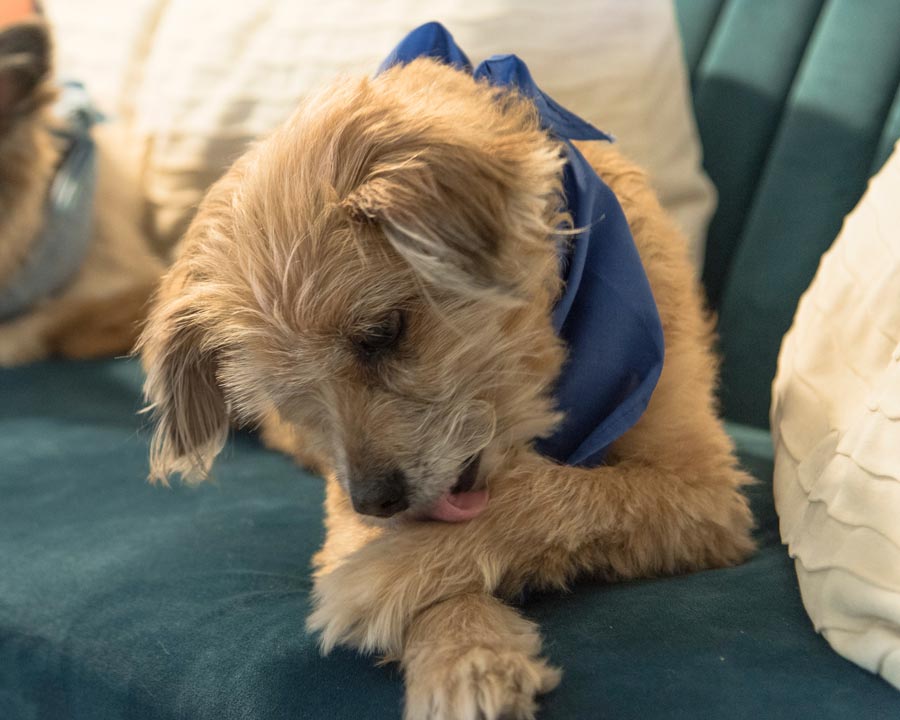
Self Grooming
Believe it or not, dogs like for their feet to feel "clean," and, much like cats, they will lick their paws to clean away dirt and debris. They will generally do this when they feel safe and relaxed. For many dogs, this is a nighttime ritual as they lay down for bed.

Skin Allergies
The most common reason for a dog's excessive paw licking and chewing is allergies - namely seasonal, environmental, and food allergies. This is especially seen during spring and autumn when the air is full of pollen, dust, and other "stuff."
Keep an eye out for general redness or inflammation of the paw, especially between toes and pads. An inflamed underbelly and watery eyes are other signs of seasonal allergies.
As they lick and chew their feet, you may notice some patchy hair loss, or even sores, which can become infected. Allergy irritations are often the instigator for other worse skin issues to develop, like hot spots or infections due to bacteria or fungi, such as ringworm or yeast. Many of our customers find that Lavengel® helps keep that from happening.
Allergies can be tricky to pinpoint, and a combination of allergens may be possible, depending on your dog's sensitivities. Finding the specific cause - especially with food allergies - may require a lot of "trial and error."
See our Atopic Dermatitis + Skin Allergies Resource page for more info on what skin allergies look like, common allergens, and how they are treated and managed.
Photo: Atopic dermatitis with general redness and hair loss on dog paw, likely due to allergies
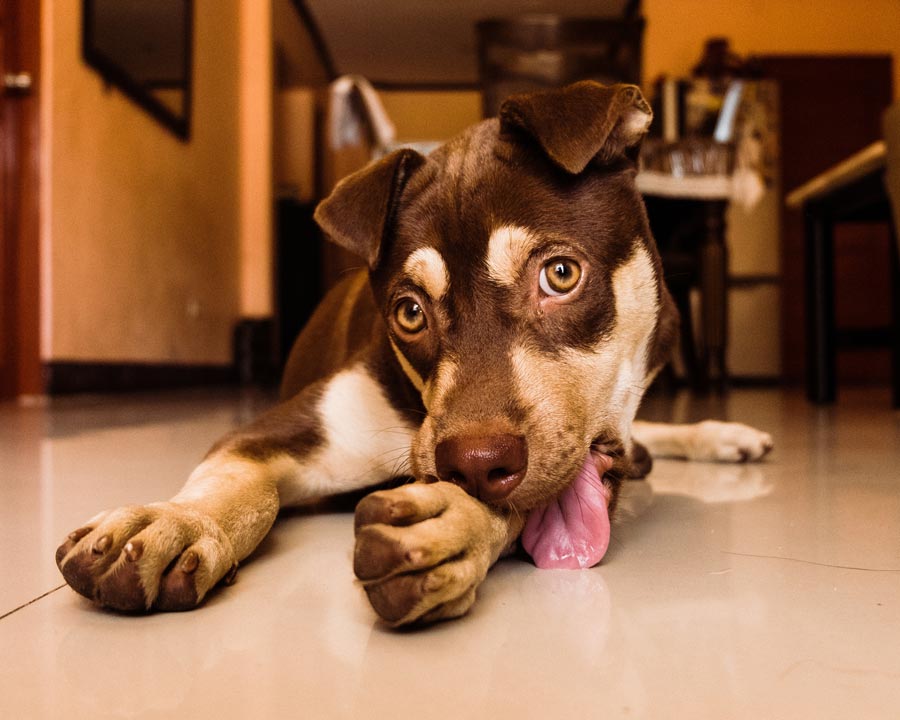
Anxiety + Self Soothing
Similar to humans biting fingernails, licking can be a reaction to stress and a way that dogs soothe themselves physically and mentally. Dogs that are learning to overcome separation anxiety or a new situation at home may be seen going at their paws more often.
Good ways to mitigate this stress are regular exercise, mentally stimulating toys, or even relaxing medications (as recommended by their vet).
Hidden Cuts, Scrapes, or Debris
The paws are where the majority of canine wounds happen, and they are sometimes hard to see. It's also very easy for debris to get lodged between toes and pads.
If your dog is licking one paw excessively, examine it. There may be a hidden cut, scrape, broken nail, splinter, piece of bark, or pebble in there that they're trying to get at.
If you find a cut or scrape, you can clean it with soap and water or paw wipes, then apply some Lavengel® to help relieve the irritation and kickstart the healing process.
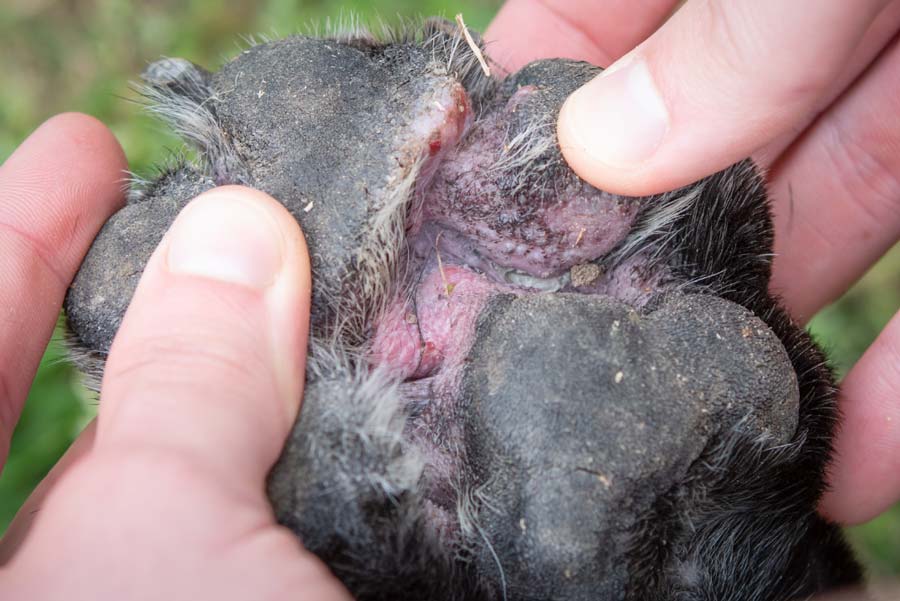
Bacterial or Yeast Infection
As skin becomes disrupted, microbes can infiltrate and create an infection (check out our Biofilms post to learn more about bacteria and their environment).
This infection can be bacterial (pyoderma) or fungal (Malassezia yeast) in nature, causing a terrible itch. Without opposable thumbs, licking and chewing become a dog's sole source of relief. The more they chew the area and the more an infection sets in, the worse that itch becomes.
Quick intervention with a topical anti-inflammatory/anti-microbial product and/or antibiotics is crucial. Otherwise, the infection will become more difficult to eradicate with time.
This is an area where Lavengel® truly shines. Not only can your dog's feet feel better faster, but you may potentially avoid a trip to the vet's office.
Dry, Cracked Paw Pads
Changes in seasons or a dog's environment can cause their paw pads to get dry and form cracks. This can be more prevalent during winter months or in regions with an arid climate.
Environmental factors, such as salt from the beach, or the salt and chemicals used to clear snowy pavement during winter, can significantly dry out pads, too. Severe dryness can lead to cracks in their paw pads. These can be uncomfortable and allow dirt, allergens, and microbes to penetrate the pad's tissue, raising the risk of allergy dermatitis or infection.
This can be avoided or mended with the right moisturizing ointment (incoming plug). Lavengel's superior moisturizing qualities and absorption not only hydrate dry paw pads, but also help repair them by provide the necessary micronutrients for producing keratin - the protein that pads are made of.

Mange, Mites + Parasites
Paws are easily accessible to fleas, ticks, and other parasites, and they can hide between toes and pads. Be sure to check in those crevices when giving your barker a bath. Keeping them on a regular flea and tick medication is never a bad idea either. See our Dog Tick Tips post for more on ticks - plus some of the top flea and tick prevention products.
Mange is a skin disease caused by microscopic parasites known as mites. There are two different kinds, demodectic (aka "demodex" or "red mange") and sarcoptic (scabies), that are caused by the two types of mites that give them their name.
Each type of mange requires different forms of treatment, but both are marked by patches of thinning or missing fur. Both forms can also bring about intense itching - especially sarcoptic mange.
Photo: Dog paw affected by sarcoptic mange mites (scabies), via customer
Arthritis or Joint Pain
Licking is one of the few ways that dogs really have to make something feel better - even if it seems illogical to us. If an external paw irritation or problem cannot be determined, the issue may be internal.
With older dogs, arthritis and joint pain may be affecting their legs and feet. On the other hand (or paw), young, fast-growing puppies may lick from "growing pain" discomfort as their joints begin to close and they adapt to the increase in weight.

Interdigital Cysts and Sores
Interdigital cysts (aka follicular cysts or furuncles) are red bumps or nodules between a dog's toes that begin as inflamed hair follicles - typically brought on by allergies and/or excess friction. These follicles disrupt surrounding tissue, creating further inflammation and form a swollen cyst that is irritating and itchy.
As a dog licks and chews the cyst, they further damage the hair follicles and skin. This can develop into an open sore and become infected.
Lavengel® can greatly help with these cysts and sores. That said, if the original inflammation is due to allergies, other anti-inflammatory allergy medications - as prescribed by your vet - may be necessary.
Photo: Interdigital cyst on dog paw, by Jennifer Bailey, DVM; via the Whole Dog Journal.
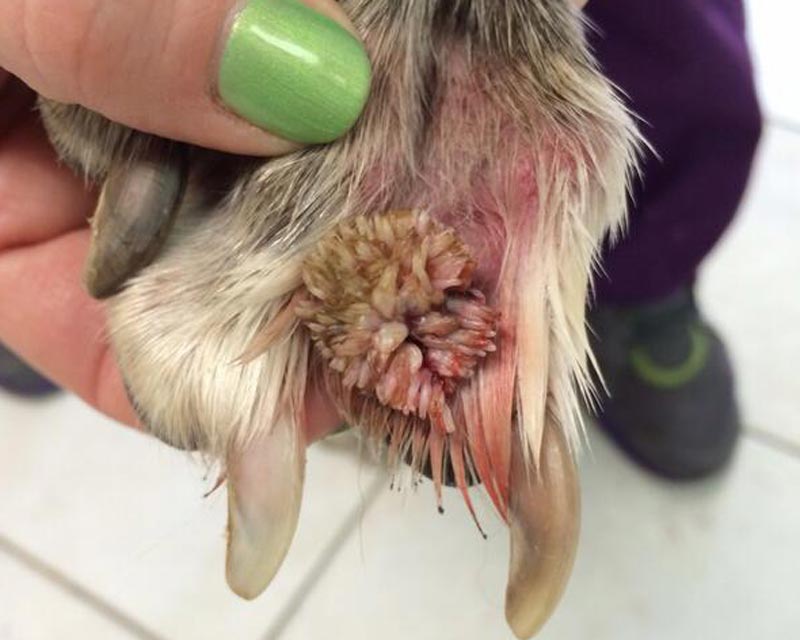
Interdigital Warts
Warts, or papillomas, are caused by the canine papilloma virus (CPV). Unlike cysts, they carry a distinct cauliflower or sea anemone appearance, and do not contain semi-fluid "juice." Though they aren't extremely common between the toes, they can happen.
CPV is spread through direct contact with the virus, which can even involve surfaces that an infected dog has touched. It gains access to the body through damaged skin - like from cuts or scrapes - which the paws are generally the first area to sustain.
Warts don't necessarily itch, but they can be aggravating between the toes, prompting a dog to lick and chew at them. Because of this interdigital warts are usually removed surgically.
Photo: Large anemone-like papilloma between dog's toes; photo by Kelsey O'Brien (@knockout0603), on X
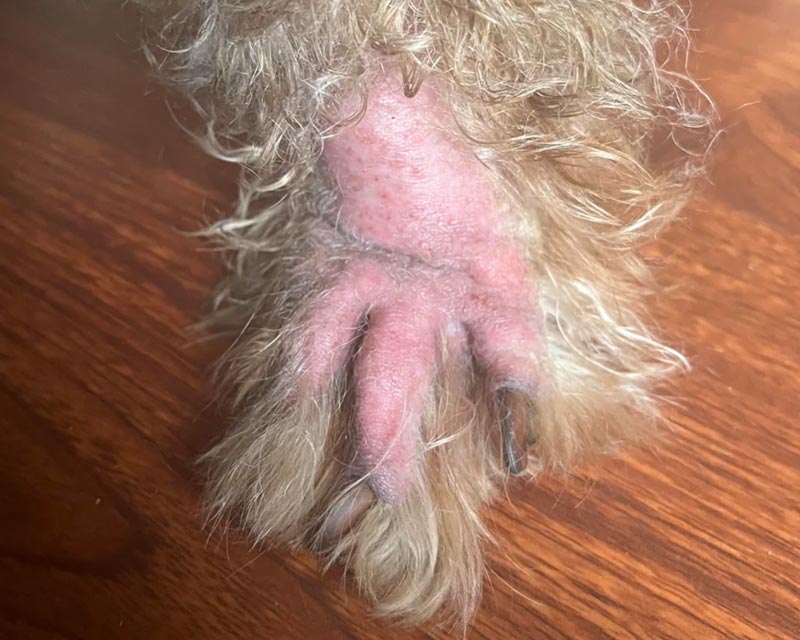
How to Treat Itchy, Irritated Dog Paws
Determining the exact cause of your dog's itchy paws is paramount to stopping the excessive licking and solving the problem. Lavengel® can help (and has) with many of these issues - cuts, allergy spots, dry paw pads, cysts, sores, infections, etc. See for yourself in some notable reviews in the section below.
However, if there is an underlying issue, such as an environmental or food allergy, parasites, or immune disorder (i.e., an internal issue), Lavengel® or any other topical will do little more than mitigate the symptoms.
That's why we highly recommend seeking veterinary consultation to get more information about your dog's specific sensitivities and health concerns.
Photo: Dog paw with missing fur, possibly from self-inflicted trauma due to skin allergies or parasites; via r/dominicantrashh on Reddit
Potent Paw + Pad Care Cream for Pups
Lavengel® is a natural, soothing ointment for itchy, irritated dog paws that relieves redness, sores, blisters, wounds, and infections on/between toes and pads.
Free standard shipping on orders over $35
30-day money back guarantee
For every unit sold, we donate to help dogs + heroes








More Canine Skin Issues to Cover
-
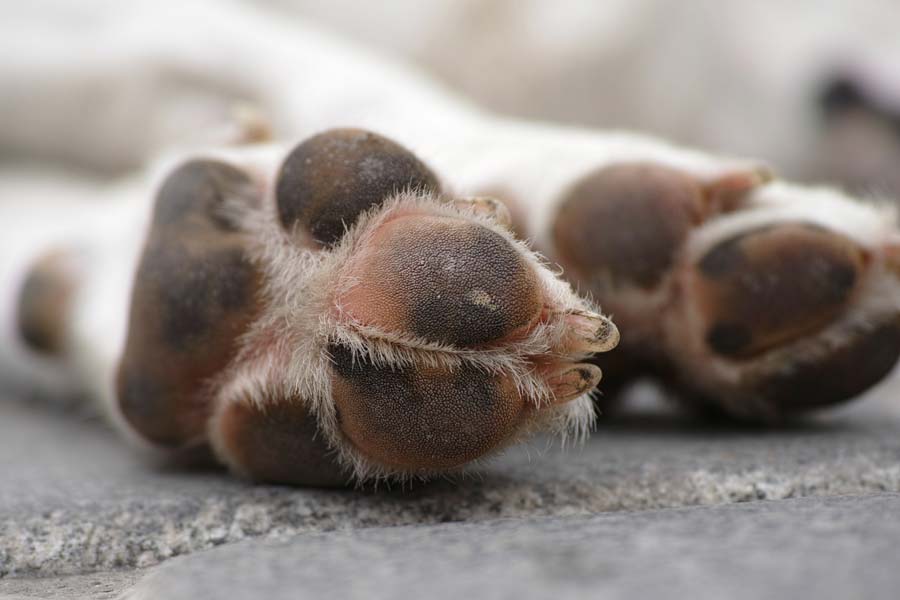
Frito Feet
Sounds corny. Let's goWant to know why your dog's feet smell like they just walked through a river of corn chips? We take a deep dive in this article.
-

Rashes + Dermatitis
Let's not be so rashDermatitis, or inflammation of the skin, comes in many shapes, forms, and locations. We look at 11 of the most common forms in dogs.
-
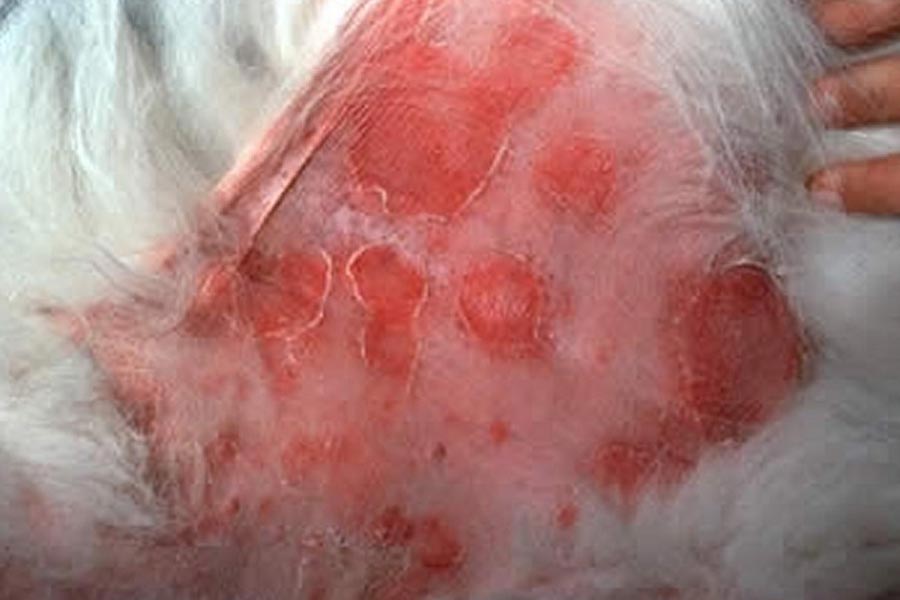
Pyoderma
See the bacterial materialAnother fancy word for "bacterial infection, typically with pus," pyoderma is one of the chief concerns when a dog's skin is damaged.





